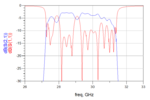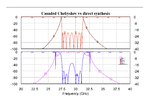Monzerje
Junior Member level 3
- Joined
- Oct 22, 2017
- Messages
- 28
- Helped
- 0
- Reputation
- 0
- Reaction score
- 0
- Trophy points
- 1
- Location
- Kuala Lumpur, Malaysia
- Activity points
- 244
I'm designing a Butterworth microstrip bandpass filter, and I have calculated its order by using Bilinear method and I got it as 31st order. The frequency band is from 27.5 GHz to 31.225 GHz, and I have tried to simulate it on ADS by using cascading method (added 10th order 3 times with 1st order) but I'm getting unexpected results for insertion and return losses as shown in the figure, I even tried to do optimization but I couldn't get any enhancement for such a high order like that, and I showed my design to my supervisor and he said that the cascading method is correct but i have to work on the performance, otherwise I have to show him a research paper saying that the cascading method has a negative effect on filter's performance. So what is wrong with my design, why I'm not getting the desired results?




